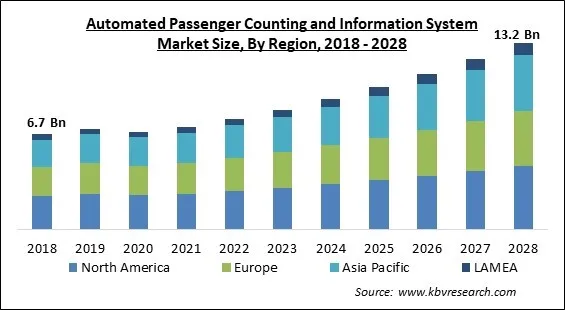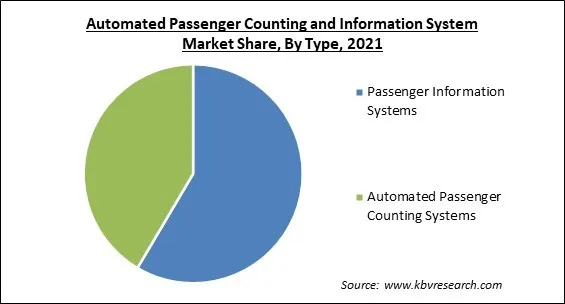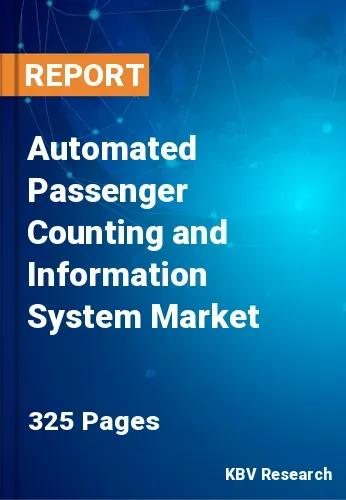The Global Automated Passenger Counting and Information System Market size is expected to reach $13.2 billion by 2028, rising at a market growth of 9.1% CAGR during the forecast period.
Automatic passenger counting systems are electronic machines that count how many passengers board and depart at each stop. Schedule checkers, which were formerly used to manually collect ridership data, have been supplanted by these technologies. Automatic passenger counting and information systems, unlike schedule checkers, capture ridership for every single trip conducted. Automatic passenger counting and information systems are cost-effective because collecting ridership data via APC devices are less expensive than hiring staff to do so manually. A passenger information system is an electronic system that gives real-time information to passengers. This provides projections for the arrival and departure times of various modes of transportation.
APC (automated passenger counting) systems keep track of when and where passengers use the service. When reviewing shifting ridership patterns, considering service adjustments, and reporting to the National Transit Database, this information is crucial (NTD).
Increasing demand for transportation is a result of today's growing population and urbanization, which necessitates a corresponding rise in mass transit supply. Counting passengers with an automated passenger counting system can help to foster methodical improvement in the urban transportation sector. For transport companies, the number of total passengers is the most crucial number. Nowadays, passenger counting operations are developed using counting systems that only provide numbers of passengers entering a vehicle rather than numbers of passengers entering and exiting, resulting in inaccurate occupancy numbers and troubles with route and vehicle optimization decisions based on these same results.

The Covid-19 pandemic had a disastrous impact on the health and wellbeing of the public as well as various industries. The passenger information system market was impacted by government regulations enacted in many nations in response to the COVID-19 crisis. A complete temporary shutdown of production facilities or their partial operations with limited personnel, as well as travel limitations, were among the measures.
As governments of most of the countries across the globe mandated nationwide lockdowns, the public transport systems basically came to a halt and as a consequence, the demand for automated passenger counting and information systems dropped significantly. People started avoiding commuting via buses and subways to protect themselves from the virus.
Fierce competition in the transportation industry is forcing the hands of transit operators to attempt to provide low-cost and reliable transportation services to passengers in order to obtain a competitive advantage. One of the most important components in boosting a company's operational efficiency is lowering operational costs. Automated passenger counting systems help the company do exactly that. Transit firms must arrange their transit vehicles' optimum frequency on busy routes to ensure that enough cars are available on high-traffic routes and that there are no vacant vehicles in order to maximize revenues and reduce operational expenses.
In the last few years, automatic passenger counting systems have seen considerable technological breakthroughs, such as the implementation of time-of-flight and stereoscopic vision technology. Manufacturers of automated passenger counting systems were able to attain incredibly high accuracy in their counting results by incorporating these technologies into automated passenger counting systems. Passengers are counted using treadle mats and infrared technologies in traditional passenger counting systems. Even little fluctuations in light or temperature can cause accuracy concerns when these systems are positioned on high ceilings or in heavy-traffic settings.
Since each system has its own security and interfacing protocols, integrating passenger information systems with other systems is difficult. As a result of linking passenger information systems with other systems, security walls are breached. Furthermore, users must have access to public transportation agency websites and reservation systems in order to get occupancy-related data in cars. The information about the number of vehicles, their arrival and departure times, their speed, and their current location is crucial in the case of railways and airlines. As a result, passenger information systems must be linked while keeping security concerns in mind to prevent data exploitation.

Based on Type, the market is segmented into Passenger Information Systems and Automated Passenger Counting Systems. The passenger information systems segment acquired the largest revenue share in the automated passenger counting and information system market in 2021. Bus transit operators can use passenger information systems to assess passenger travel trends and schedule the times and routes of their services. The fierce competition among bus companies to improve their service offerings and win more consumers is leading to an increase in the deployment of passenger counting equipment on buses. These devices give real-time data to assist transit operators in ensuring that their buses run smoothly and without problems during COVID-19. Passenger information systems are also becoming more widely employed in railways because they provide real-time data on vehicle occupancy levels. They're also utilized for infotainment and to keep passengers safe with emergency communication systems in the event of an emergency.
On the basis of type, the Passenger Information System Market is segmented into Display Systems, Announcement & Emergency Communication Systems, Infotainment Systems, and Mobile Applications. The display systems acquired the largest revenue share in the automated passenger counting and information system market in 2021. In the PIS sector, display systems are digital information systems that show passengers real-time information. Station ticket halls, station platforms, station entrances, interchange corridors at interchange stations, and other modes of transportation all have these systems installed to show vital information about metro/train timings and metro/train destinations to passengers. The passenger may access real-time information both in the station and onboard owing to the display system, which uses various disruptive technologies such as IoT, big data, cloud, AI, ML, and automation.
On the basis of Application, the Passenger Information System Market is segmented into Railways, Roadways, and Airways. The railways acquired the largest revenue share in the automated passenger counting and information system market in 2021. Although the railway is a completely different mode of transportation, it also faces competition. Some passengers choose ridesharing firms because of their regularity, availability, and comfort. However, railway operators (private and public) must improve services and reduce prices to stay competitive. Passengers riding trains must have a favorable experience; they must be informed that the train will arrive soon, or at the very least that it will be delayed. Passenger Information Systems (PIS) provide services that are similar to those provided by these ridesharing firms in terms of convenience and predictability. These services are in line with the requirements of today's passengers.
On the basis of Application, the Automated Passenger Counting Systems Market is segmented into Buses, Ferries, and Trains & Trams. The buses segment acquired the largest revenue share in the automated passenger counting and information system market in 2021. Buses are a common means of public transportation in many nations, including the United States, Canada, Germany, the United Kingdom, China, India, and Australia. The market for buses is growing due to a growing awareness among operators of the benefits given by automatic passenger counting systems. In order to schedule the time and route of their buses, bus transport operators are interested in establishing passenger travel patterns. The introduction of automatic passenger counting systems in buses is being driven by the fierce competition among bus operators to improve their service offerings and obtain an increased number of customers. The trains and trams sub-segment obtained a substantial revenue share in the automated passenger counting and information system market in 2021. Live occupancy counts are provided by automated passenger counting systems, which can be accessed by a meter, a smartphone, a web browser, or the Internet of Things. This helps determine the actual number of passengers on each train and tram and assists in adhering to social distancing norms and suggestions.
On the basis of Technology, the Automated Passenger Counting Systems Market is segmented into Infrared, Stereoscopic vision, Time of Flight, and Others. The stereoscopic segment obtained a substantial revenue share in the automated passenger counting and information system market in 2021. It collects accurate data from large amounts of traffic data. Furthermore, this technology is capable of detecting the direction in which passengers are going. Stereoscopic vision technology is a passive technique since it simply uses ambient light from the surrounding environment and does not utilize any external light, making it suitable for usage outdoors with enough lighting. The stereo camera has a strong sensor that performs all of the processing to get the photos instantaneously at a better resolution.
| Report Attribute | Details |
|---|---|
| Market size value in 2021 | USD 7.2 Billion |
| Market size forecast in 2028 | USD 13.2 Billion |
| Base Year | 2021 |
| Historical Period | 2018 to 2020 |
| Forecast Period | 2022 to 2028 |
| Revenue Growth Rate | CAGR of 9.1% from 2022 to 2028 |
| Number of Pages | 325 |
| Number of Tables | 539 |
| Report coverage | Market Trends, Revenue Estimation and Forecast, Segmentation Analysis, Regional and Country Breakdown, Companies Strategic Developments, Company Profiling |
| Segments covered | Type, Region |
| Country scope | US, Canada, Mexico, Germany, UK, France, Russia, Spain, Italy, China, Japan, India, South Korea, Singapore, Malaysia, Brazil, Argentina, UAE, Saudi Arabia, South Africa, Nigeria |
| Growth Drivers |
|
| Restraints |
|
Based on Regions, the market is segmented into North America, Europe, Asia Pacific, and Latin America, Middle East & Africa. The Asia Pacific region acquired a significant revenue share in the automated passenger counting and information system market in 2021. The increasing implementation of passenger counting and information systems in transit vehicles to provide reliable, secure, and timely transportation services might be credited to the market's rise in the Asia Pacific. The vast population bases of countries like China and India, as well as the ever-increasing populations of nations like Australia, necessitate the development of smart transportation networks to provide passengers with a dependable and secure travel experience.
Free Valuable Insights: Global Automated Passenger Counting and Information System Market size to reach USD 13.2 Billion by 2028
The market research report covers the analysis of key stake holders of the market. Key companies profiled in the report include EUROTECH S.p.A., INIT Innovation in Traffic Systems SE, Cisco Systems, Inc., Samsung Electronics Co., Ltd., Hitachi, Ltd., Siemens AG, HELLA Aglaia Mobile Vision GmbH, Infodev Electronic Designers International, Inc., and DILAX Intelcom GmbH.
By Type
PIS Market, By Type
PIS Market, By Application
APC Systems Market, By Application
APC Systems Market, By Technology
By Geography


The global automated passenger counting and information system market size is expected to reach $13.2 billion by 2028.
Rising technological developments in automated passenger counting systems are driving the market in coming years, however, costs and difficulty in integration of passenger information systems with other systems of transit vehicles growth of the market.
EUROTECH S.p.A., INIT Innovation in Traffic Systems SE, Cisco Systems, Inc., Samsung Electronics Co., Ltd., Hitachi, Ltd., Siemens AG, HELLA Aglaia Mobile Vision GmbH, Infodev Electronic Designers International, Inc., and DILAX Intelcom GmbH.
The expected CAGR of the automated passenger counting and information system market is 9.1% from 2022 to 2028.
The North America is the fastest growing region in the Global Automated Passenger Counting and Information System Market by Region in 2021, and would continue to be a dominant market till 2028.
Our team of dedicated experts can provide you with attractive expansion opportunities for your business.

